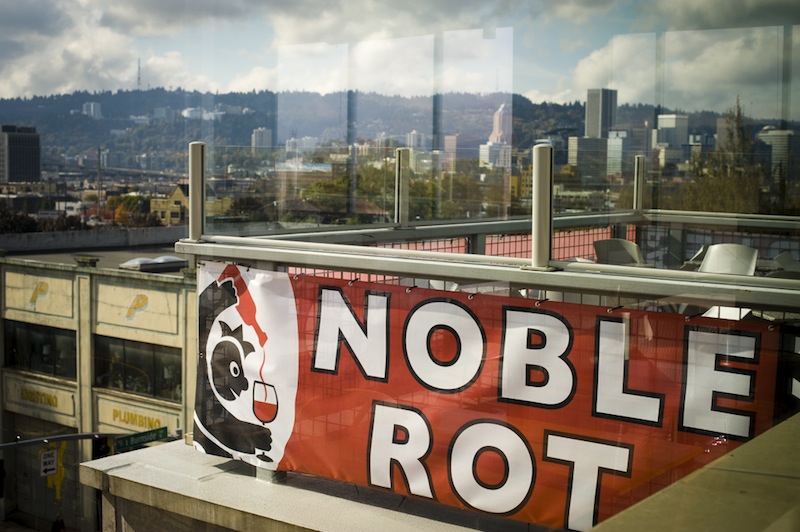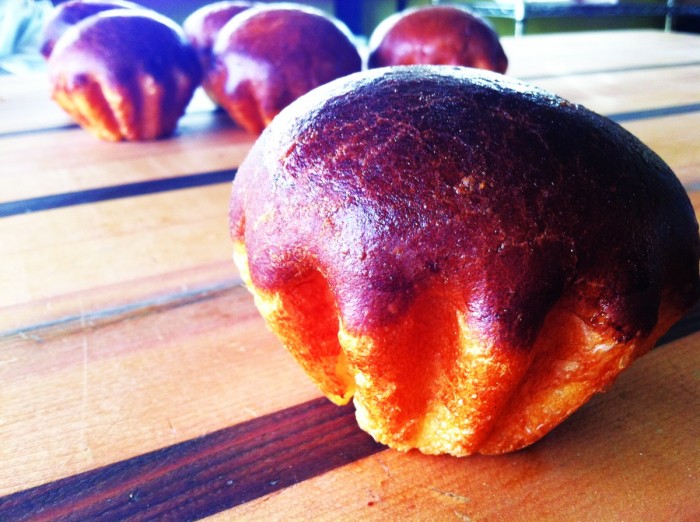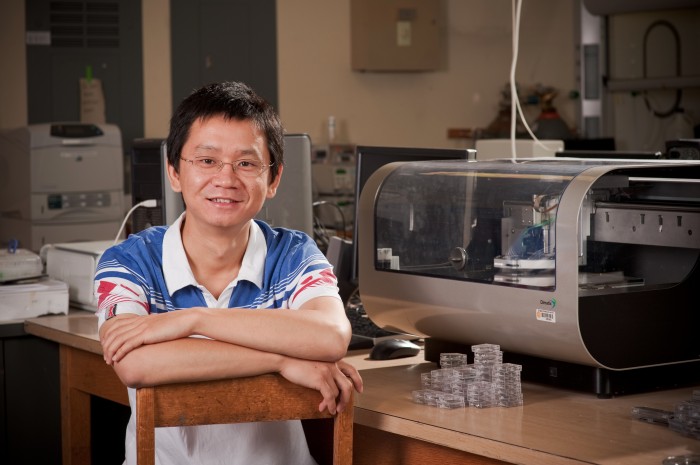Leather Storrs is a brash former bad boy who crashed and burned his first restaurant, Rocket. In 2011, he won Food Network’s Extreme Chef by cooking a flank steak on a muscle car engine block. And there’s his name, more fitting for an outlaw than gourmand. So, how could this guy be a role model of the farm-to-table chef?
On an unusually sunny fall day in Portland, Storrs crouches over a raised bed in the rooftop garden of Noble Rot, the wine bar he owns with his wife, Courtney, and business partner Kimberly Bernosky. His hands move with familiarity through the lacey leaves of what looks like cilantro. “Delfino,” he says, in a voice that sounds like rocks stirred in a water glass. “I prefer it to cilantro, because it’s more mild.” He touches the tendrils with an improbable delicacy for such meaty hands he calls his “Fred Flintstone mitts.”
At this stage, the plants are going to seed. “I love to pick things at varying stages of development, the natural progression,” he says, pulling off the tiny green rounds he’ll brine like capers. “Here’s the plant, here’s the seed—seeing the cycle.”
Born and raised in Portland, Storrs started in the kitchen at the Heathman Hotel more than twenty years ago. His formal education at the Culinary Institute of America included a six-week internship at Chez Panisse with Alice Waters. For locavores, that’s the modern equivalent of consulting the clairvoyant, Pythia, at the Oracle at Delphi. Storrs was unfazed. “I showed up at 7 a.m. and spent seven hours rinsing and spinning lettuce in a crappy home-sized spinner,” he remembers.
His career from there was no less dicey—stints as head chef, caterer, assistant winemaker and restaurant reviewer for Citysearch— as was his reputation after his failed Rocket in 2009. “I got into cooking for the idea that I could impose myself on food,” he offers. As a devotee of molecular gastronomy, he expressed his style using space-age techniques Storrs now sees as technology for technology’s sake. “I step back more now,” he observes. “When working with a turnip, I express the ‘turnipness’ to show people the turnip we harvested when it was little, and have them taste our soil.”
Since taking over the menu at Noble Rot three years ago, Storrs also guest chefs at sold-out Plate & Pitchfork farm dinners. His mushroom foraging expertise brought him a guest host gig on ABC’s “The Chew,” a program about food. On a daily basis, he tends his aquifer-fed eco-roof garden plot with sweeping views of the Willamette River and Portland’s west side. He dedicates all 3,000 square feet to growing edibles. His mantra for menu planning is, “Let the roof decide.”
“It’s so sad this time of year,” he says, surveying the fall crops. Sure, the sungolds have dropped into the soil, but there are still lush plots of mustards, mizuna, kale and arugula at their sweetest. There is the broccoli Storrs grows for its satiny, mildly cabbage leaves and Hungarian hot peppers. There are timely Mission figs—“a day away from ripe,” he declares after sampling. There are beehives that amazingly produced a few quarts of honey in their first year.
Today, he harvests the first of the radicchio to put on the menu. Scarlet-rimmed heads crowd the bed like floral bouquets—beautiful and bitter. “I thought I’d ice it in a couple of changes of water to rescue some sweetness,” Storrs announces. “Then, we’ll char it and wrap it in our bacon.”

With tiny scissors a tailor might use, Storrs selects from his plots penny-sized nasturtium leaves, young sorrel and the last yellow beans. His experience runs deep, beginning, as a child, with weeding his mother’s vegetable garden in southwest Portland. For the restaurant, his intimacy with each plant means that each ingredient is ideally fresh and diners get a true sense of the cycle of farm to table. “A surprising number of cooks don’t know how things grow,” muses Storrs.
This rooftop garden produces about sixty percent of Noble Rot’s needs from July to the third week in September. After that, Storrs resorts to “a lot of pickling, drying and hot sauce.” The rest he sources from loyal producers. He’s no purist, no Alice Waters, nor does he strive to be.
Downstairs in the kitchen, Storrs soaks and sears the radicchio, but, lacking bacon, improvises with house-smoked duck breast. The renaissance chef cures all his own meats, makes sausage and ferments sauerkraut and kimchee. The completed dish is a whole head of radicchio di Treviso drizzled with house honey, wrapped in duck and plated with baby turnips, and a salad of sorrel, nasturtium leaves, sliced hot pepper and the delfino. The roof has decided.
“You have to be creative, think on your feet to see what’s at the market on any given day,” counsels this out-of-the-ordinary farm-to-table chef. “It’s dangerous to stick to a recipe.”
All photos by Leah Nash








